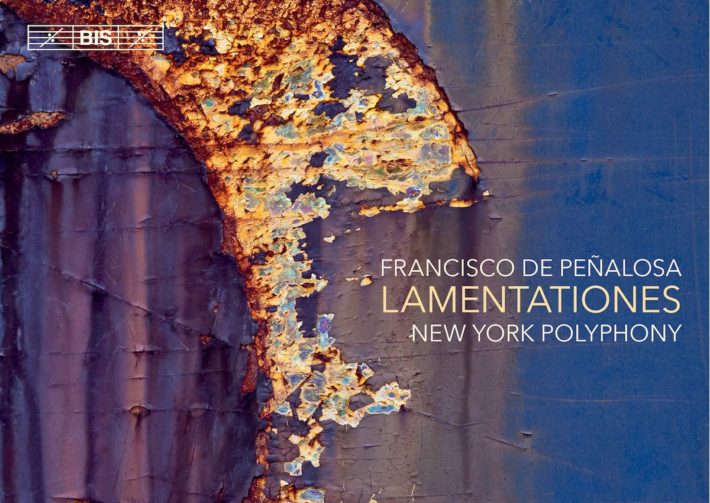A museum is more than its murals and masterpieces. Its more intimate collections — the side rooms and the back corners with the small sculptures and quick sketches — are often just as rewarding. This goes, too, for New York Polyphony’s well-curated, latest album, which centers on a Francisco de Peñalosa’s 1516 work “Lamentationes,” but which fills in the gaps with wonderful, smaller treats by Peñalosa as well as his contemporaries Pedro de Escobar and Francisco Guerrero.
“Lamentationes” sets the Biblical texts by the same name (frequently attributed to the prophet Jeremiah) that depict the destruction of Jerusalem. The first passage here describes the ensuing sorrow, and the second depicts the Lord’s anger. Though Peñalosa was writing in the 15th and 16th centuries, this album is the first recording of this music, so the Lamentations are the main attraction here. NYP’s singing is sumptuous, the brush strokes of their voices heavy and rough. Their tone suits a text about destruction and abandonment. Their interpretation is, as usual, subtle. They take no musical chances and don’t push stylistic boundaries, but there are plenty of particular moments to be admired. These include, in Feria 5 (track 1), the hushed tone on the word “lamentations” and “nec invenit requiem” (“but finds no rest”), or in Feria 6, the highlighting of the word painting on “cast down from heaven to earth.” On a critical note, though, over the twenty minutes of the piece, the group misses many other moments to be expressive, and the large scale of the work becomes difficult to take in when delivered in a monotone.
As mentioned, each of the other pieces on the album provides a welcome contrast to the Lamentations. The two Song of Songs settings are uplifting pieces in an otherwise dark and serious exhibit, and the Guerrero in particular (track 8) provides a veritable masterclass in text painting. The voices strive to out-do each other on the words “ascends out of the desert like the rising dawn.” A motif of a perfect fourth is paired with the line “fair as the moon;” the ensuing “bright as the sun” gets the more radiant perfect fifth, sung first beautifully by Geoffrey Williams, the counter-tenor (1’30” – 2’30”). The other piece by Guerrero on the album (track 9), a song in a more “popular” style, sees NYP let loose a bit. They throw their weight around a bit, and show what they can do with an accent or two. The group unfolds the mournful harmonies of Escobar’s Stabat Mater (track 2) with sophistication, and also reveal a diverse vocal color palette that was missing from the Lamentations.
A Welcome Addition
The excerpts from Peñalosa’s “Missa l’Homme armé” are well-sung, and are welcome additions to the set of “L’Homme Armé” masses already on record. In the Renaissance, it was common for composers to write whole pieces based on one melodic theme. “L’homme Armé” is perhaps the most popular of those themes, forming the melodic basis for many dozens of works. While this album does not include the original “L’homme Armé” melody, it is easily found online and should be heard before listening to these movements, so that one can listen for how Peñalosa has integrated the melody with the Latin text. To modern sensibilities, using a popular song in a mass may seem satirical, but Peñalosa would have taken his work seriously, and the New York Polyphony performs the movements appropriately.
From a technical perspective, throughout the album, New York Polyphony delivers a stellar performance. Their intonation is flawless, frankly far surpassing that of their peer vocal groups. Their warm-up regimen, documented in a charming online segment available on NPR, includes exercises that help them “meld on vowels [amidst complex chord changes] in split-second time,” and it shows. Major chords are warm without losing brightness. Minor seconds (“ghimel,” 7’02”, track 3) and unisons (throughout) are impeccable. Their articulation of the text is precise. The recording quality of the album is also top-notch, capturing the complexities of their voices without sacrificing resonance.
This album is a wonderful success, and solidifies lots of positive trends in New York Polyphony’s development. As in a great museum, there is something for everyone here, whether religious or atheist, classical-enthusiast or first-time listener. New York Polyphony may has room to grow, but as long as they’re performing at this level, few will be complaining.

“Lamentations” – Music by Peñalosa, Escobar and Guerrero
New York Polyphony:
Geoffrey Williams – Counter-Tenor
Steven Caldicott Wilson – Tenor
Christopher Dylan Herbert – Baritone
Craig Phillips – Bass
BIS Records, Hybryd SACD BIS-2407
You May Also Like
Follow Us and Comment:
Get our periodic classical music newsletter with our recent reviews, news and beginners guides.
We respect your privacy.








